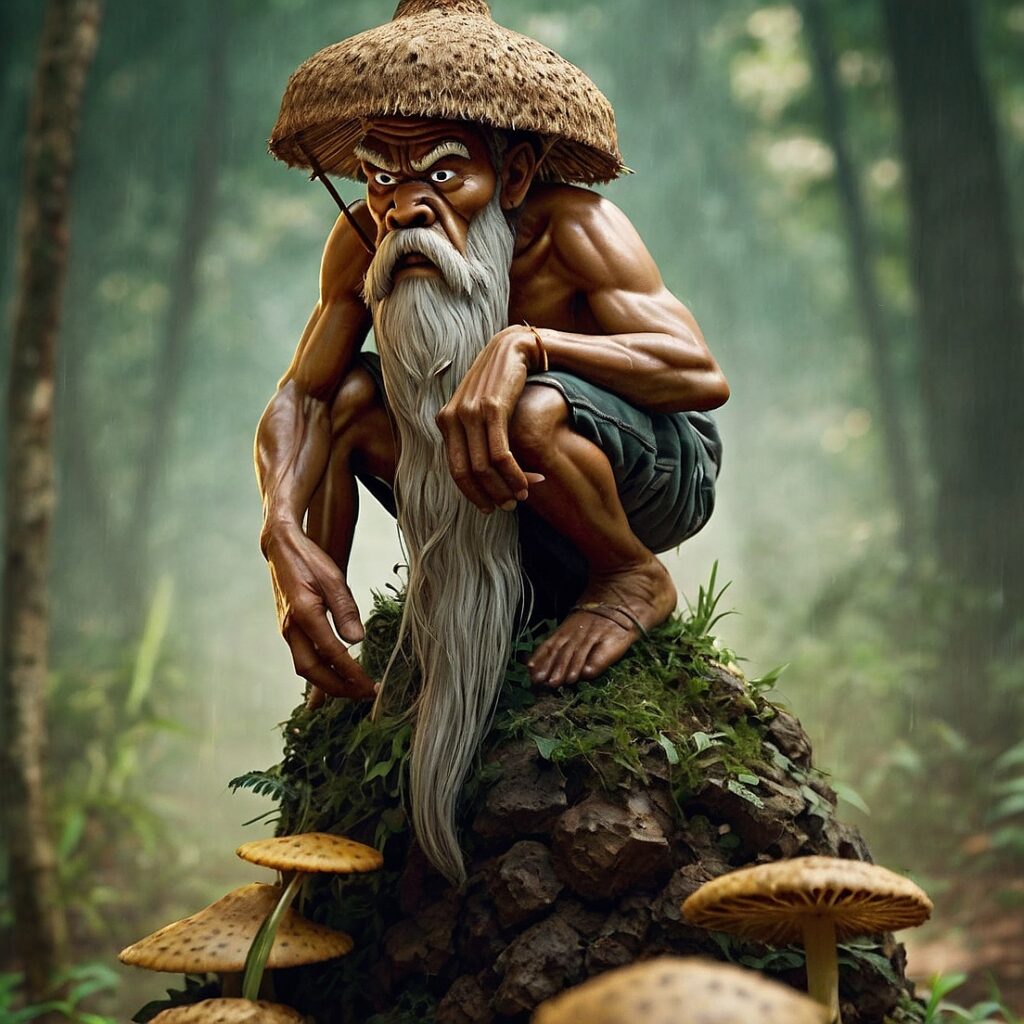The Philippines, an archipelagic nation with a rich tapestry of cultures and traditions, is home to a diverse array of mythical creatures that have captivated the imagination of its people for generations. Among these fascinating beings, the duwende holds a special place in Filipino folklore. These diminutive entities, often described as mischievous and elusive, have been an integral part of the country’s oral traditions and superstitions for centuries. This comprehensive exploration delves into the world of the duwende, examining their characteristics, origins, and the role they play in contemporary Filipino culture.
Defining the Duwende
Physical Appearance and Characteristics
Duwende, also known as “nuno sa punso” (old man of the mound) in some regions, are typically depicted as small, humanoid creatures standing no taller than a few feet. Their appearance varies depending on the specific folklore of different Philippine regions, but they are generally described as having wrinkled skin, long beards, and clothing reminiscent of traditional Filipino attire. These beings are said to possess supernatural powers, including the ability to become invisible, cast spells, and influence human affairs.
Habitat and Dwellings
According to popular belief, duwende make their homes in various natural settings, with a particular affinity for areas close to human habitation. They are often associated with:
- Anthills or termite mounds (punso)
- Large trees, especially balete trees
- Rocks or boulders
- Underground caverns or burrows
- Secluded areas in gardens or forests
This proximity to human settlements contributes to the frequent interactions between duwende and people in Filipino folklore.
Origins and Cultural Significance
Historical Context
The concept of duwende in Filipino folklore can be traced back to pre-colonial times, with influences from various indigenous beliefs and later, foreign mythologies. The arrival of Spanish colonizers in the 16th century brought new elements to these existing beliefs, often blending them with European fairy tales and Christian concepts. This syncretism resulted in the complex and multifaceted duwende lore that exists today.
Cultural Importance
Duwende play a significant role in Filipino culture, serving as:
- Moral teachers: Stories involving duwende often carry lessons about respect for nature and proper behavior.
- Explanations for natural phenomena: Duwende are sometimes credited with causing unexplained events or illnesses.
- Guardians of the environment: They are seen as protectors of natural spaces, discouraging human encroachment.
- Cultural identifiers: Belief in duwende is part of the shared Filipino experience, contributing to national identity.
Types of Duwende
Filipino folklore recognizes several types of duwende, each with its own distinct characteristics and behaviors. The most commonly mentioned types are:
| Type | Description | Associated Color | Temperament |
|---|---|---|---|
| White Duwende | Benevolent and helpful | White | Friendly |
| Black Duwende | Malevolent and harmful | Black | Hostile |
| Red Duwende | Mischievous pranksters | Red | Playful |
| Green Duwende | Nature spirits | Green | Neutral |
| Gold Duwende | Guardians of treasure | Gold | Protective |
It’s important to note that the specific attributes and behaviors associated with each type can vary depending on the region and the storyteller.
Interactions with Humans
Positive Encounters
Interactions between humans and duwende are not always negative. In some stories, these creatures are portrayed as helpful beings who can bring good fortune to those who treat them with respect. Positive encounters may include:
- Assistance with household chores
- Guidance in finding lost objects
- Protection from harm or evil spirits
- Bestowing of gifts or magical objects
- Sharing of secret knowledge or wisdom
Negative Encounters
More commonly, duwende are associated with mischievous or malevolent actions towards humans. Negative encounters often described in folklore include:
- Causing illness or misfortune
- Kidnapping children or leading travelers astray
- Playing pranks or creating disturbances in homes
- Cursing individuals who have offended them
- Possessing humans or influencing their behavior
Duwende in Filipino Superstitions and Practices
Beliefs and Taboos
The belief in duwende has given rise to numerous superstitions and practices in Filipino culture. Some of the most prevalent include:
- Saying “tabi-tabi po” (excuse me) when passing by areas believed to be inhabited by duwende
- Avoiding cutting down old trees or disturbing anthills
- Leaving offerings of food or small objects to appease the duwende
- Consulting faith healers or albularyo for ailments believed to be caused by duwende
- Incorporating protective charms or rituals into home construction
Regional Variations
The specific beliefs and practices associated with duwende can vary significantly across different regions of the Philippines. For example:
- In the Visayas, duwende are often associated with the kapre, another mythical creature
- In Mindanao, some indigenous groups have more elaborate classifications of nature spirits that include duwende-like beings
- In urban areas, beliefs about duwende have evolved to incorporate modern settings and scenarios
Duwende in Popular Culture
Literature and Media
The fascination with duwende has extended beyond traditional folklore into various forms of popular media:
- Books and comics featuring duwende characters or inspired by their lore
- Television shows and movies that incorporate duwende into their storylines
- Documentaries exploring Filipino folklore and supernatural beliefs
- Online content, including vlogs and social media posts discussing duwende encounters
Tourism and Local Attractions
Some areas in the Philippines have capitalized on the popularity of duwende folklore to attract tourists:
- “Duwende forests” or parks with statues and attractions based on mythical creatures
- Guided tours of areas said to be inhabited by duwende
- Souvenir shops selling duwende-themed items and protective charms
- Cultural events and festivals celebrating Filipino folklore, including duwende stories
Scientific and Skeptical Perspectives
Rational Explanations
While belief in duwende remains strong in many parts of the Philippines, skeptics and scientists offer alternative explanations for phenomena attributed to these creatures:
- Misidentification of natural phenomena or animals
- Psychological factors, including suggestibility and pareidolia
- Cultural conditioning and the power of folklore in shaping perceptions
- Medical conditions that may cause symptoms similar to those attributed to duwende encounters
Anthropological Insights
Anthropologists and folklorists study duwende beliefs as part of the broader cultural heritage of the Philippines. Their research provides valuable insights into:
- The evolution of Filipino mythology and its influences
- The role of supernatural beliefs in shaping social norms and behaviors
- The adaptation of traditional beliefs to modern contexts
- The function of folklore in preserving cultural identity and values
Conservation and Environmental Connections
Ecological Significance
The belief in duwende and other nature spirits has had an unexpected positive impact on environmental conservation efforts in the Philippines:
- Protection of old-growth trees and forests believed to be duwende habitats
- Preservation of natural landmarks and geological formations
- Promotion of respect for nature and sustainable practices
- Integration of traditional ecological knowledge into modern conservation strategies
Challenges and Opportunities
While duwende beliefs can support conservation efforts, they also present challenges:
- Balancing development needs with respect for cultural beliefs
- Addressing conflicts between traditional practices and scientific conservation methods
- Educating the public about the ecological importance of areas traditionally associated with duwende
- Leveraging folklore to promote environmental awareness and sustainable tourism
The Future of Duwende Folklore
Evolving Beliefs
As Filipino society continues to modernize, beliefs surrounding duwende are evolving:
- Reinterpretation of traditional stories in contemporary contexts
- Integration of duwende concepts into new forms of spirituality and New Age beliefs
- Use of duwende folklore as a means of cultural expression and identity affirmation
- Adaptation of duwende narratives to address modern social and environmental issues
Preservation Efforts
Recognizing the cultural importance of duwende folklore, various initiatives aim to preserve and promote these traditions:
- Documentation projects to record oral histories and local variations of duwende stories
- Inclusion of folklore studies in educational curricula
- Government-supported cultural programs celebrating Filipino mythology
- Collaboration between artists, writers, and traditional knowledge holders to create new works inspired by duwende lore
Conclusion
The duwende of Filipino folklore represent a fascinating intersection of mythology, culture, and environmental consciousness. These diminutive beings have captured the imagination of generations, shaping beliefs, practices, and even conservation efforts across the Philippines. While scientific skepticism challenges the literal existence of duwende, their cultural significance remains undeniable. As the Philippines continues to navigate the complexities of modernization and globalization, the stories of the duwende serve as a poignant reminder of the rich tapestry of beliefs that have shaped the nation’s identity. Whether viewed as literal entities or powerful metaphors, the duwende continue to play a vital role in Filipino culture, bridging the past and present while offering insights into the relationship between humans and the natural world.
Disclaimer: This article presents information on duwende based on Filipino folklore and cultural beliefs. It is intended for educational and entertainment purposes only. The author does not claim the literal existence of duwende or endorse any specific beliefs or practices associated with them. Readers are encouraged to approach the topic with cultural sensitivity and critical thinking. If you notice any inaccuracies or have additional information to contribute, please report them so we can correct and update the content promptly.




